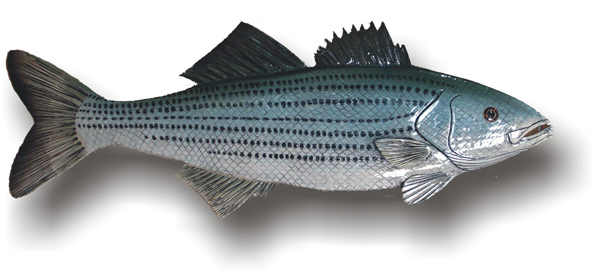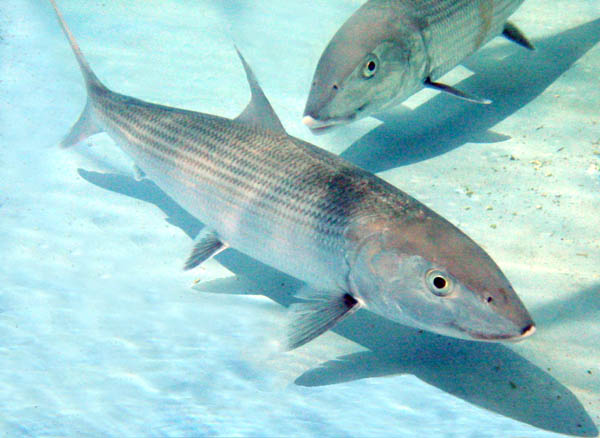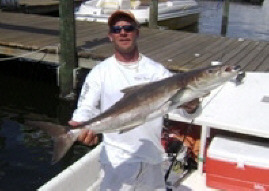Discover Florida Nature
It's time to explore the natural Florida


|
|
|
|
|
 Bluefish
(Pomatomus saltatrix) The bluefish also know as tailor
(Australia), shad (South Africa) and elf (west coast) is a popular game
fish that can be found off the coast of Florida during the winter
months. The bluefish is most commonly a sea-green color above, fading
into a silvery shade on its lower sides and belly. Bluefish rarely
exceed 20 pounds and 40 inches in length. These broad forked tailed fish
are voracious and are the only known fish that will kill for the sake a
killing. Adult bluefish are opportunistic feeders, commonly focusing
upon schooling species such as menhaden, squid, sand eels, herring,
mackerel, alewives, scup, butterfish and cunners. Bluefish generally
feed in schools, actively pursuing prey in tidal rips or in inshore
shallows where food in easier to catch. The feeding behavior of
bluefish is legendary! Bluefish are reputed to dash wildly about within
schools of prey species, biting, crippling and killing numerous small
fish that do not get eaten. Bluefish frequently drive schools of prey
species into shallow inshore areas where it becomes easier to cripple or
catch fish that are trying to escape. Bluefish
(Pomatomus saltatrix) The bluefish also know as tailor
(Australia), shad (South Africa) and elf (west coast) is a popular game
fish that can be found off the coast of Florida during the winter
months. The bluefish is most commonly a sea-green color above, fading
into a silvery shade on its lower sides and belly. Bluefish rarely
exceed 20 pounds and 40 inches in length. These broad forked tailed fish
are voracious and are the only known fish that will kill for the sake a
killing. Adult bluefish are opportunistic feeders, commonly focusing
upon schooling species such as menhaden, squid, sand eels, herring,
mackerel, alewives, scup, butterfish and cunners. Bluefish generally
feed in schools, actively pursuing prey in tidal rips or in inshore
shallows where food in easier to catch. The feeding behavior of
bluefish is legendary! Bluefish are reputed to dash wildly about within
schools of prey species, biting, crippling and killing numerous small
fish that do not get eaten. Bluefish frequently drive schools of prey
species into shallow inshore areas where it becomes easier to cripple or
catch fish that are trying to escape.  Bonefish
(Albula vulpes) Bonefish are named for the many fine
bones they contain. Bonefish are also commonly known throughout the
world as banana, bananafish, Indo-Pacific bonefish, ladyfish, round jaw,
salmon peel, tarpon, tenny, and tenpounder. Bonefish appear
blue-greenish on the top and top half of its body with bright silver
scales on the sides and underneath. The average size of bonefish in
Florida waters and the Bahamas' range from 4-6 pounds, with fish over 8
pounds regarded as large. However, bonefish found in Africa and Hawaii
can attain weights over 20 pounds. The bonefish inhabits tropical and
warm temperate waters worldwide and although western Atlantic bonefish
can be found as far north as North Carolina, New York, and New
Brunswick, this species of fish is most plentiful in south Florida, the
Bahamas, and Bermuda. Bonefish love the coastal area and are commonly
found in intertidal flats, mangrove areas, river mouths, and deeper
adjacent waters. They can be found in any flats whether sand or grass to
rocky substrates. Bonefish can tolerate the oxygen-poor water they
sometimes encounter in coastal habitats by inhaling air into a lung-like
air bladder. It is not unusual to see bonefish school, sometimes in
groups of up to 100 individuals. In south Florida bonefish prey on
crustaceans such as crabs and shrimps, mollusks particularly clams and
snails, polychaete worms, and some fish primarily the gulf toadfish. The
gulf toadfish is commonly found in the stomachs of larger bonefishes. Bonefish
(Albula vulpes) Bonefish are named for the many fine
bones they contain. Bonefish are also commonly known throughout the
world as banana, bananafish, Indo-Pacific bonefish, ladyfish, round jaw,
salmon peel, tarpon, tenny, and tenpounder. Bonefish appear
blue-greenish on the top and top half of its body with bright silver
scales on the sides and underneath. The average size of bonefish in
Florida waters and the Bahamas' range from 4-6 pounds, with fish over 8
pounds regarded as large. However, bonefish found in Africa and Hawaii
can attain weights over 20 pounds. The bonefish inhabits tropical and
warm temperate waters worldwide and although western Atlantic bonefish
can be found as far north as North Carolina, New York, and New
Brunswick, this species of fish is most plentiful in south Florida, the
Bahamas, and Bermuda. Bonefish love the coastal area and are commonly
found in intertidal flats, mangrove areas, river mouths, and deeper
adjacent waters. They can be found in any flats whether sand or grass to
rocky substrates. Bonefish can tolerate the oxygen-poor water they
sometimes encounter in coastal habitats by inhaling air into a lung-like
air bladder. It is not unusual to see bonefish school, sometimes in
groups of up to 100 individuals. In south Florida bonefish prey on
crustaceans such as crabs and shrimps, mollusks particularly clams and
snails, polychaete worms, and some fish primarily the gulf toadfish. The
gulf toadfish is commonly found in the stomachs of larger bonefishes. Cobia
(Rachycentron canadum) The Cobia is a large, long, slim bodied
fish with a broad depressed head, a protruding lower jaw. At first
glance when scuba diving cobia can be mistaken due to its shark like
shape and well proportioned size. The Cobia body is elongate and
torpedo-shaped with a long, depressed head. The eyes are small and the
snout is broad. The lower jaw projects past the upper jaw. The Cobia is
overall a dark brown color with a prominent dark lateral stripe that
runs from the eye to the tail. Its distinguishing first dorsal fin is
composed of 7 to 9 spines that are not connected by a membrane. The
Cobia is a sleek and extremely strong fish. They range in size up to
about 135 pounds. The largest Cobia ever caught in Florida weighed about
104 lbs. An average size fish will weigh 20 to 40 pounds. Cobia
(Rachycentron canadum) The Cobia is a large, long, slim bodied
fish with a broad depressed head, a protruding lower jaw. At first
glance when scuba diving cobia can be mistaken due to its shark like
shape and well proportioned size. The Cobia body is elongate and
torpedo-shaped with a long, depressed head. The eyes are small and the
snout is broad. The lower jaw projects past the upper jaw. The Cobia is
overall a dark brown color with a prominent dark lateral stripe that
runs from the eye to the tail. Its distinguishing first dorsal fin is
composed of 7 to 9 spines that are not connected by a membrane. The
Cobia is a sleek and extremely strong fish. They range in size up to
about 135 pounds. The largest Cobia ever caught in Florida weighed about
104 lbs. An average size fish will weigh 20 to 40 pounds. Cobia are found around the world in tropic and warm temperate waters. Remoras are often seen swimming with cobia. They migrate so their numbers will very with the seasons. Cobia inhabit the warm tropical waters in the winter and move to more temperate waters in the spring, summer and fall. Cobia prefer water temperatures between 68 and 86 degrees Fahrenheit. Along the Atlantic Coast of Florida, Cobia spend the winter (December – March) in the harbors and around the wrecks and reefs of the south Florida Keys, since they love to be near structures. In late March, early April they begin their northward migration up the Atlantic Coast reaching Fernandina Inlet in late May, early June. Along the Gulf Coast, Cobia inhabit the Panhandle area in late February, early March. They travel southward along the coast beginning in April and peaking all along the Gulf Coast in July and August. Cobia are voracious eaters and will eat their prey whole. They are carnivores, feeding on crustaceans and small fishes such as mullet, eels, jacks, snappers, pinfish, croakers, grunts, and herring. A favorite food of cobia is crab which is why they have the common name of "crabeater". Cobia will often cruise in packs of 3-100 fish, hunting for food during migrations in shallow water along the shoreline making an incredible sight if you are fortunate to see them. This fish is well known by many common names including cobia, black kingfish, black salmon, cabio, crabeater, cubby yew, kingfish, lemonfish, ling, prodigal son, runner, sergeant fish, and sergeantfish. The Cobia is a powerful fish and a thrilling catch. It is one of the most sought after game fish to catch. |
|
|
Advertise | Privacy Statement | Contact | Alaska Nature | Michael Arnold Art| Dog Encyclopedia | Dog Encyclopedia| |
|